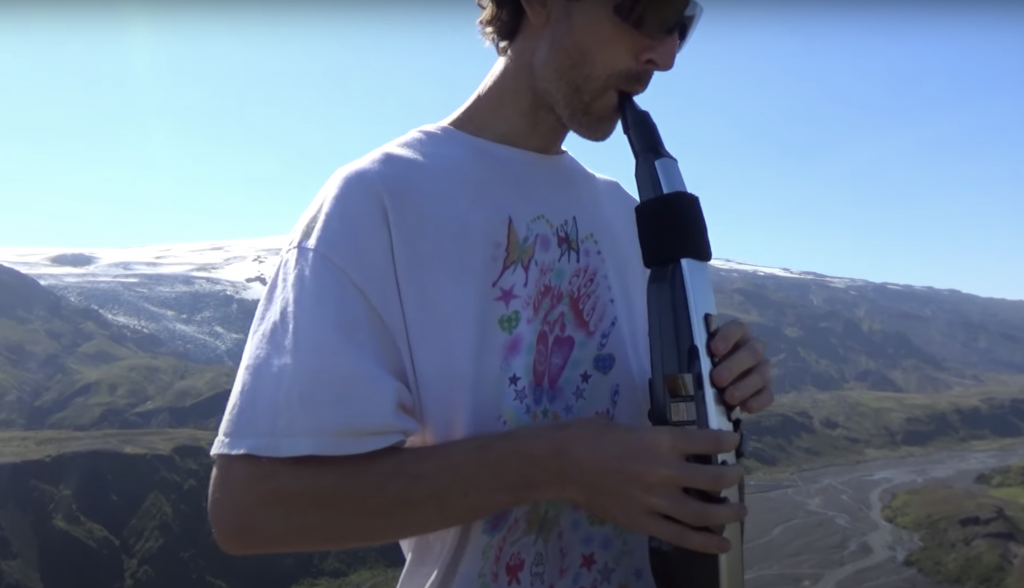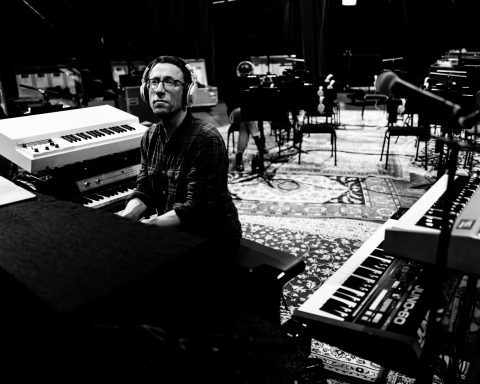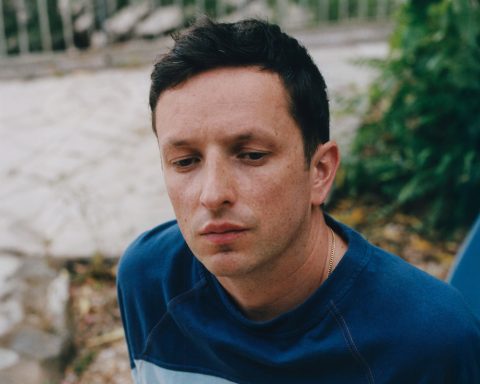Sam Gendel is an iconoclast. The young musician blurs lines between improv and composition, classic and modern. Described by LA Times as a “jazz trickster,” a recent example of his magic is AE-30 (LEAVING RECORDS), an album and documentary film of the same name. Composed entirely on the Roland Aerophone Pro while traveling in Iceland, AE-30 encapsulates Gendel’s ethos. While taking in stunning vistas, he created soundscapes that defy notions of how a wind instrument can sound. Seated in front of a vintage tape machine in his LA studio, Gendel spoke about AE-30: the instrument, album, and film.
Point of Entry
When did you get the AE-30, and what were your initial takeaways?
I got the AE-30 in the spring of 2021. Initially, I played an Aerophone in 2018. Tomoichiro Oono from Roland brought one to a performance I was doing in Japan. I remember being backstage playing it on headphones, not quite understanding my own point of entry. Still, I knew that eventually, I was going to find my way. Then I did, almost three years later.
So here we are in late 2021 and you’ve released AE-30. Did you create all the sounds with the Aerophone Pro?
Besides talking or ambient noise, every musical sound is from the instrument alone. Period. That was the rule. I said, “I’m going to dive in and explore the instrument.” There are a lot of parameters to control with it. I explored and messed with the delays and all the other effects. It’s all performances on the instrument.
"Besides talking or ambient noise, every musical sound is from the instrument alone. Period. That was the rule."
Outside the Norm
The sounds fall outside of what listeners may imagine from a digital wind instrument. BLKSND, for example, consists entirely of percussive elements.
On BLKSND, I used a drum kit. That’s where the instrument excels. People have an idea of an instrument because we’re so inundated with visual and aural input all the time. The AE-30 interface leads you to a different take on instruments. You can play drums, but because of the linear layout of sax fingerings, you’re not going to play them like a drummer.
Creative Partnership
What is your collaborative process like with Marcella Cytrynowicz? How did you come up with the concept for this film?
Marcella saw me with the AE-30 and how I was using it at home. The way she hears and filters things influences what I do. She had this idea to do something with the instrument. To take it somewhere and use that as a way of drawing something out of it. She’d been to Iceland a few times and thought the instrument and the sound I was leaning into would make sense there.
"The AE-30 has so much power and potential for expression on various levels. It drew something out of me and in a cool, different way."
Were there any unexpected twists or things you discovered in the process?
Marcella can disassociate herself from what’s going on in the world, to look at the subject she’s trying to capture. We tried to get inside the instrument by making it almost a character in the film. She saw the humor in it and rides that line masterfully. It was the two of us going to create something based on this idea, using the instrument as the backbone.
A Character Guide
How did you meet Viktor Einar Villhemson, the Icelandic search-and-rescue volunteer who served as your guide?
Victor is Marcella’s friend who she met through video work in the past. He’s an expert on Iceland’s terrain. Victor is a character and is so funny. Because he’s lived his whole life there, he was kind enough to take us along with him to spots he loves and thought would be beautiful to film. It was exactly what we hoped. He even has a song on the album, “VIKTOR’S BLUES.”

Improv and Impressions
Was all the music composed on the trip, or did you have ideas beforehand?
I had some things prepared beforehand that I wanted to explore. It’s a mix of some things that were in the moment and a couple of more prepared pieces. This offered flexibility. There were a couple of nods to old tunes done in a weird way—like “Nature Boy” which we filmed in front of a glacier. Literally, we had to be there for that to come out.
"We tried to get inside the instrument by making it almost a character in the film."
What were your impressions of Iceland?
It was my first time. Marcella had been three times, and I’ve wanted to go since high school, but it just never lined up. We would live there. Culturally, we felt connected to the overall view of life. There is also the most incredible water we’ve ever been able to drink.
You’ve made a mark pushing what instruments can do. Where does the AE-30 fit into your approach?
The AE-30 has so much power and potential for expression on various levels. It took me a long time to grasp, but it drew something out of me in a cool, different way. The instrument is its own thing, and I use it for certain things that need a specific type of expression.

Live to Virtual Tape
What recording gear did you use while traveling?
It was all recorded into Logic. You can record audio over the USB, but I mostly opted for the quarter-inch input to play like I was tracking to a tape recorder. For this film, I thought it best to demonstrate the actual instrument itself. Even the effects I use are the onboard ones. As deep as I did go, there’s way more. It’s beyond my capabilities how much you can do with it.
"For me, I base everything on music and instinct and my ear."
Instinct and Ears
You’ve been profiled in The New Yorker and on Netflix shows for playing uncompromising music. Did you ever expect to make a career doing what you do?
I don’t think of what I do as a career—I keep making things and if they get received, I’m grateful. At this point, I don’t know what a career in music means. I’m always working in so many different aspects of music. These days, it’s naturally, very slowly, becoming a more external part of my life. There are careers people have where it’s easier to identify the parameters. For me, I base everything on music and instinct and my ear.






